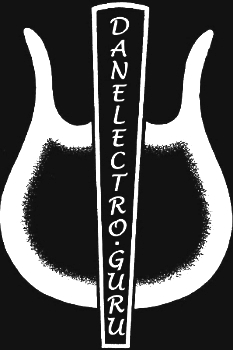Dan Armstrong was modifying and selling Danelectros long before he came up with the Ampeg See-Through guitar. When he’d opened his NYC music store, the franchises for Fender, Gibson, etc, were already sewn up by his neighboring dealers. He recognized Danelectros as being essentially good guitars that were easily improved, and he set about making his initial reputation by selling upgraded Danelectros in his shop.
He did two main things with them, the first being getting rid of the “skate-key” tuners that Nat Daniel made in-house from about 1963 on. I’m not sure on this, but Dan may have had a unique deal with Danelectro, buying guitars from them before the tuners were attached: Dan’s all came with individual chrome Klusons, and there are no extra holes where skate-key ones would have mounted. The other thing he did was dump the stacked pots, replacing them with a single volume and tone, plus replacing the standard tone cap with a .022. He was a gigging musician, and found the stacked pots awkward to use in a live situation. (There’s some mid-60’s photos of Van Morrison gigging in the mid-60s, and you can see Dan in the background on a bass he’d made from a black “Page Model” body and a Longhorn neck he made a similar bass for the Youngblood’s Jesse Colin Young.) One sign of his shop-modified Danelectros was that they always had black Gibson domed knobs. The Longhorn bass you see Jack Bruce playing in photos of the NYC studio Disraeli Gears album is also one of Danny’s jobs.
When the Danelectro company folded, Ampeg was having a slow time getting the Plexi guitars into production, and there was already a lot of buzz about them. Dan saw an opportunity to get some guitars with his name on the market almost immediately by buying some of Danelectro’s unfinished stock. Using leftover 1-cutaway Silvertone bass bodies, he made a guitar and bass model of “Dan Armstrong Modified Danelectros.” The bass used a standard Danelectro lipstick pickup, while the guitar’s potted pickups actually had Danelectro pickup coils embedded in them, sans lipstick tube covers. I got that straight from Dan himself. He also wanted a physically larger pickup, since everyone wanted chunky humbuckers on their guitars then. What I don’t recall is whether he paired coils in the epoxy as humbuckings (One of the things that impressed him about Danelectros is that Nat Daniel had wired his two-pickup models so that when both pickups were on, they were in series, forming a humbucking circuit.) Whether it’s one coil or two in there, he potted it/them so it could take the high volume and fuzztones of the day without squealing. I think he’d learned about potting from Bill Lawrence, who did a lot of the design on the Plexiglass’ pickups.
When the Ampeg Plexi came out, Dan told music writer Richard Robinson, “There’s a lot of Danelectro in this guitar.” The bridge was certainly one of the things that influenced him, but the Plexis do not have actual Danelectro bridges on them. The design was similar, but they’re rectangular, rather than the Danelectro’s trapezoidal shape, and are mounted flush with the body instead of being raised and adjustable via three screws. The Dan Armstrong bridge came with three fretwire-topped rosewood saddles of different heights, allowing players to choose the action that best suited them. (Those who used the guitars for slide, such as Jo Jo Gunne’s Matt Andes, preferred the highest one).The three-way toggle on the switch was standard on single-pickup Danelectros. Nat designed a clever circuit: in the center position the tone knob was defeated; to one side it had it function as a standard treble roll-off tone control; to the other side it actually cut lows to give a more trebly sound. The cheap Carling switches Danelectro used crap out over the years. With the switch in the center position, push down on it and spray some contact cleaner into the switch, wiggle it like crazy, and you should have a working switch again for several months, then repeat.
The Ampeg-distributed “Dan Armstrong Modified Danelectro” models were sold nationally through music stores, not just at Danny’s shop. The bass player in my high school band bought one new in a Fullerton music shop. The initial models were not solid poplar, but were constructed much the same way the later guitars were, with a masonite top and back on a poplar frame. The chief difference between the first 1954 guitars and the Danelectros most of us know and love is that the original neck was essentially a rectangular tube aluminum that had a rosewood fingerboard on top and wood sections glued on to give it the shape of a traditional neck. (The pickups also initially lacked the lipstick tubes, but were mounted in raised sections under white molded plastic pickguards). The neck idea was radically ahead of its time—the tube actually ran well into the body, terminating by the bridge–but it also didn’t work well: the wood tended to separate from the aluminum, so sometime in 1955, he’d switched to using a more traditional neck construction, but with twin steel beams instead of an adjustable truss rod. These guitars had a U-2 shape, but with a smaller “peanut” body. They went full-sized by 1958, and were joined around then by the longhorn models.It should also be noted that Dan’s post-plexi, London-built guitars differ considerably from the plexi models. They have more of a double-cut Les Paul Junior shape, with a deep body and no contours, and the single humbucking pickup slid on a rail under the strings. – Jim Washburn.
Photos: Doug Tulloch




